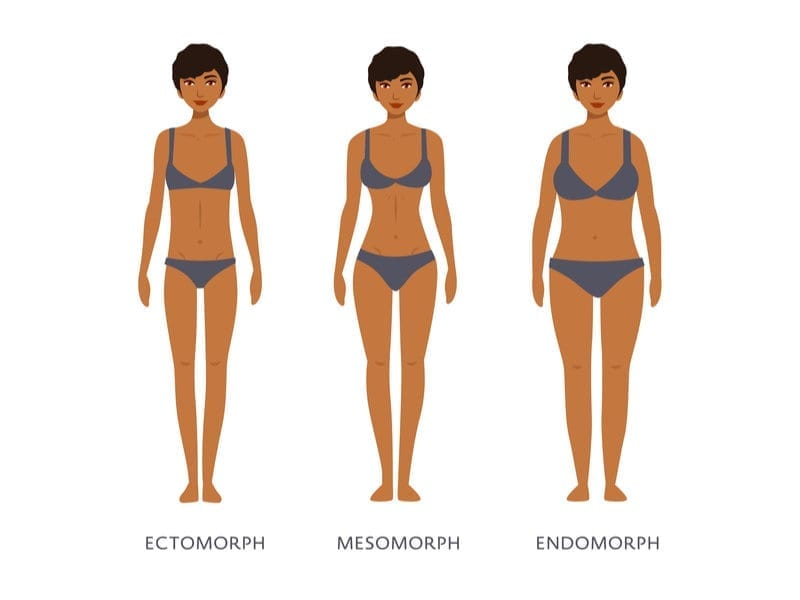Each person has a unique physique and physical traits. Their combination is known as a somatotype. In constitutional psychology, our bodies can be divided into three types, applied to men and women.
Understanding your type can help you determine the perfect fitness routine and nutrition.
Ready to identify your body type? Let’s dive in.
What Do You Mean by Somatotype?
As defined by American psychologist William Herbert Sheldon, your somatotype is your body type.
In addition, somatotypes are associated with certain types of behavior.
According to Dr. Sheldon, people with mesomorph body types need to be aware of their competitive spirit and ectomorphs may want to work on developing their assertive communication.

What are the three types of somatotypes?
All people are born with unique body composition and skeletal frames. And yet, there are common characteristics that you can identify. In fact, there are just 3 somatotypes that group these universal physical traits.
The three main somatotypes are ectomorph, mesomorph, and endomorph.
Dr. William Sheldon introduced them in his text on constitutional psychology back in the 1940s. Since then, the theory has been useful in determining individual fitness routines and nutrition.
What Are the 3 Different Body Types?
Here are the features that define ectomorphs, mesomorphs, and endomorphs.
1. Ectomorphs
Most basketball players and fashion models fit the ectomorph category. They are quite tall and lean with minimal body fat. Ectos are not muscular and they might find it difficult to put on weight.
This can be a blessing or a curse, depending on your fitness goals.
On the bright side, there are some quick exercises that can help ectomorphs achieve their desired shape.
2. Mesomorphs
Many people assume mesomorphs are genetically blessed. And this is true in some respects.
Their bodies are inherently muscular and strong. In addition, mesomorphs find it easy to lose and gain weight due to their metabolism.
So, what do mesomorphs actually look like? Well, female mesomorphs usually have an hourglass figure and the males are adorned with broad shoulders and narrow hips.
Mesomorphs usually get quick results regardless of their fitness routine.
3. Endomorphs
Imagine an NFL lineman and you’ll get an idea of what a typical endomorph looks like.
In general, an endomorphic body type has both muscle and fat. Endomorphs put on weight easily but shedding the excess pounds is a completely different ballgame.
Most endomorphs tend to be a bit rounder than other types, but this doesn’t make them overweight.
For example, Marilyn Monroe is a good example of a female endomorph.

Who Came Up With Somatotypes?
They say “you can’t judge a book by its cover.” However, in the early 1940’s American psychologist William Herbert Sheldon attempted to do just that.
He proposed that he was able to establish a connection between a person’s physical build and their likelihood to commit a crime. He called it the Somatotype theory.
What is somatotype theory?
William Sheldon proposed a theory of how certain body types (or somatotypes) are associated with specific personality characteristics.
Based on his research, he classified people into 3 generalized somatotypes: endomorphs, mesomorphs, and ectomorphs.
His research was conducted on 200 juvenile delinquent men comparing them to non-delinquent college students over a span of 10 years.
He found that many of the juvenile delinquent men had “mesomorphic” body types when compared to the college student control group who had “ectomorphic” body types, and each had specific behavioral and personality traits.
Today, Sheldon’s work is dismissed as anecdotal and in today’s modern practices his theory and findings are considered to be wacky.

Which body type is aggressive?
According to Sheldon’s theory, physical characteristics go hand in hand with personality.
Sheldon suggests that mesomorphs are usually considered the most aggressive of the three types. And some may even argue that their uninhibited temperament makes them prone to problematic behavior and delinquency.
Either way, most mesomorph body types often display traits of a “somatotonic” personality. As defined by Dr. Sheldon, this means active, always on the go, and exceptionally assertive.
Should we assume that a person is prone to unacceptable behavior just because he or she is a mesomorph? No, because nurture plays just as big a role as nature.
As mentioned, by today’s standards, Sheldon’s ideas on personality are outdated and somatotypes theory is used mainly in defining the right exercise routine.
The Final Word
Getting to know your somatotype and everything that comes with it is just the tip of the iceberg. Because the truth is, to let your potential shine, you need a healthy balance of exercise and a good diet.
Remember…
Everybody knows how to get in shape. Eat right and exercise more. That’s the bottom line.
– Dr. Sheldon










